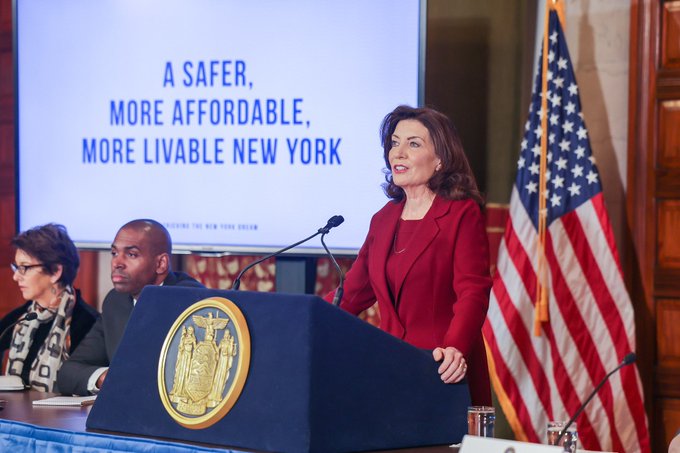Good morning from Albany, New York…
The Legislative Session kicked off in earnest last week as Governor Kathy Hochul unveiled her State Fiscal Year 2023-24 Executive Budget Proposal on Wednesday. The $227 billion proposal utilizes the state’s current surplus while also preparing for weakening economic indicators on the horizon as well as the end of federal COVID-19 relief funds from the American Rescue Plan Act (ARPA).
Perhaps the best part of the budget release was the timing! O’Donnell & Associates would like to commend the Executive Chamber and Division of the Budget staff for posting the bills in the middle of the afternoon, unlike the midnight release of budget bills for the past decade. Acting Budget Director Sandra Beattie also did an excellent job highlighting the fiscal backdrop to the 2023-24 process in her first address as leader of the Division of the Budget—certainly worth a watch.
Notably, Hochul’s proposal included a record increase in school aid, the largest Medicaid plan in the State’s history, new revenue for the Metropolitan Transportation Authority (MTA), and a number of controversial provisions including new charter schools for New York City, plans to build more affordable housing across the state, and additional changes to 2019’s bail reform laws.
More on these proposals and the battles to come below, but first, a quick look at the highlights included in this year’s proposal:
- The first tranche of funding and policies associated with a $25 billion multi-year housing plan to bolster affordable housing stock across the state;
- A new office called GO-SEMI that would work with Empire State Development to drive continued growth at Micron and other computer chip companies seeking to expand in New York;
- Major revenue raisers for the MTA in an effort to avoid cuts, including an increase on Payroll Mobility Tax projected to generate around $800 million, and a proposal to force NYC to cover about $500 million in losses the MTA sees annually;
- $1 billion for a fifth round of the Statewide Healthcare Transformation Fund;
- Support for SUNY and CUNY including increases in critical maintenance funds, $200 million for expanded research at SUNY flagships, as well as language allowing for flexibility in setting tuition at those campuses;
- $700 million to bolster mental health programs statewide;
- Legislative language indexing minimum wage to inflation & allowing for cost-of-living adjustment increases for human services workers across the State;
- $225 million in grants and tax credits for the next round of Regional Economic Development Councils competition;
- $200 million for opioid and drug user “harm-reduction” initiatives;
- $67 million for the Office of Cannabis Management to establish a “comprehensive regulatory structure to monitor and control the cultivation, processing, manufacturing, distribution, transportation and sale of cannabis.”
Taken together, the budget is further evidence that Governor Hochul is committed to pushing her vision for New York State—responsible fiscal management (using surplus money to spin up investment in reserves), progressive (fully funding Foundation Aid and robust Medicaid spending), and focused on public safety (changes to bail, money for DAs, and gun safety). The Legislature is likely to not be impressed by the first, love the second, and be very mixed on the third.
Speaking of the Legislature, Hochul’s budget shows she is willing to take on some major policy fights with her colleagues in Albany and even offers some challenges to her ally New York City Mayor Eric Adams. “Nothing I do in the budget is driven by politics, elections, outcomes. I’m guided by what is best for New Yorkers,” said Hochul.
These are the key fights that will dominate discourse in Albany, New York City, and across the State in the coming weeks—and could even ensnare the budget past the April 1 start of State Fiscal Year 2023-24—that you will want to keep an eye on:
- Bail Reform—The budget proposal includes changes to the State’s cash bail laws for the third time since the landmark reforms were passed in 2019. Specifically, Hochul’s plan would give judges more latitude when setting bail. “All I’m trying to do right now is remedy that inconsistency that exists in law. And by focusing on the serious offenses, I believe that we should be able to garner the support,” said Hochul. Changes proposed last year by Hochul held up the budget process by nine days. This year, the politically explosive issue again sets Hochul and her counterparts in negotiations—Assembly Speaker Carl Heastie and Senate Majority Leader Andrea Stewart-Cousins—on a collision course in advance of the April 1 deadline. Both legislative leaders have been circumspect on the proposal to date, however, last week Heastie was very clear in saying he does not believe crime has been driven by changes to the bail law.
- Housing—The Governor’s proposal to build 800,000 affordable housing units over the next ten years has stoked familiar tensions in suburbs throughout the State. Last year, suburban leaders killed an affordable housing proposal to allow for accessory dwelling units. More broadly, Hochul’s supporters say that local control of zoning has blocked necessary housing for decades, so a key pillar of her plan is to allow Albany to override this local opposition unless certain housing goals are met. However, the same opponents that killed last year’s proposal are back, pressuring Legislative Leadership to scale back the Governor’s goals around housing production targets and kill the Albany override. “Just the idea to paint the entire state with the same broad stroke? It makes absolutely no sense to me. Look, do we need additional housing? Of course we do, but local control is critical,” said Senator Anthony Palumbo, a Republican representing Eastern Suffolk County on Long Island.
- Charter Schools—Governor Hochul recommended policy changes that would allow new charter schools in New York City. Specifically, the proposal eliminates the regional cap on charters in New York City, and authorizes the reissuance of “zombie charters,” which were previously approved but had been shut down. While the proposal drew praise from Charter School advocates across the State, the Governor faces a major fight with the Legislature and teachers unions in the coming weeks. “We are deeply disturbed and disappointed by the Governor’s proposal — which she failed to include in the State of the State — to eliminate geographic restrictions on the charter cap,” Senators Shelley Mayer, Chair of the Senate Education Committee, John Liu, Chair of the Senate New York City Education Committee, and Robert Jackson, who also sits on the City Education Committee said in a joint statement.
- MTA—Fights over the MTA between Governors and Mayors are nothing new. However, given the mutual admiration recently between Hochul and Adams, the proposal for New York City to cough up $500 million to cover losses on paratransit and MetroCards for students has raised eyebrows in some circles. The proposal has already sparked some backlash at City Hall: Adams said “the city annually contributes approximately $2 billion to the MTA in direct and in-kind contributions and, while we recognize the significant fiscal challenges the MTA faces, we are concerned that this increased commitment could further strain our already-limited resources.”
- Cap and Invest—Hochul included a proposal to create a “cap and invest program” to raise billions of dollars and lessen the impact of the investments necessary to meet goals around reduced emissions and increased renewable energy laid out in 2019’s Climate Leadership and Community Protection Act on ratepayers across the State. The proposal also would set an annual declining limit on those allowances to achieve an 85% reduction in Greenhouse gas emissions from 1990 by the year 2050. Controversially, Hochul’s proposal allows “energy-intensive” and “trade-exposed” facilities to receive their allowances for free. Both progressive advocates and energy producers are aligned in their opposition of the carve out for certain industries that they say “picks winners and losers.” “How you determine who gets allowances and who doesn’t, and who has to pay for them, is going to be incredibly controversial,” said Gavin Donohue, President & CEO of the Independent Power Producers of New York.
- Gas Hook-Ups— The Governor’s all-electric buildings proposal would ban gas hook ups/equipment in new construction in a phased approach starting January 1, 2026. The proposal would obviously include gas stoves in new construction—not existing homes—something that has created the same ire in New York State that President Biden’s Energy Department garnered amidst rumors of a national ban on gas stoves. The Proposal would be fully phased in January 1, 2035 and would include all single family, multifamily, and commercial construction (but excludes generators).
- Healthcare—Perhaps Hochul’s veto of the lone remaining bill to be acted on from 2022 last week—the Grieving Families Act, which would have made changes to the state’s Wrongful Death Statute, one of the most restrictive in the Country—was a preview of a good Executive Budget year for hospitals. Most notably, the Executive Budget proposes “Pay & Pursue” legislation requiring health plans pay hospitals claims upfront with a retroactive—instead of up front—utilization review, a long sought after priority of hospitals across the State. While it may not garner as many headlines, expect a battle over Pay & Pursue that could have major implications on Medicaid’s bottom line, especially as organized labor across the State pushes back on potential premium increases. What else is notable is what was not in the Budget on healthcare—aside from a brief mention in the Briefing Book—Governor Cuomo’s Fee-for-Service carveout of the Medicaid Drug Benefit and the catastrophic impact it will have on safety net healthcare across the State if it goes into effect April 1 were not contemplated in statute, leaving many providers and patients across the State who hope to see it repealed holding their breath for the Legislative One House Budgets in a few weeks.
- What Was Not in the Budget—Speaking of things that were NOT in the budget… Many advocates expected to see more extensive green policy recommendations from the Climate Action Council’s Final Scoping Report codified in the Executive Budget. Outside of the cap and trade and all electric buildings proposals listed above, the Executive Budget did not contain a lot of the proposals many environmental advocates had wanted to see. Notably, it does not include the $10 billion in funding for clean energy projects that climate activists have asked for.
- Additionally, the budget omitted any labor protections, including further clarifications on prevailing wage for renewable energy or protections for workers throughout the construction industry on the heels of last year’s successful push on contractor registration. Expect those frustrations, coupled with the LaSalle nomination, to continue to boil over in the coming months.
- Taxing the Rich—Hochul was reticent to raise taxes in her Executive Budget Proposal, saying “a majority of economists are predicting a recession, and that’s one of the reasons it’s clear to me why we will not be raising income taxes this year.” Progressive groups—including Strong Economy for All and the Invest in Our New York Campaign—are pushing back on that notion and saying that refusing to increase taxes on the State’s wealthiest will hurt needy New Yorkers who need the help heading into a potential recession. “Tax increases on working people are unpopular and difficult. Tax increases on the wealthy are popular and effective. I think the legislature can make the right call on this even if the governor can’t,” said Michael Kink, with the lobbying group, Strong Economy for All.
In Washington, D.C., President Joe Biden will give his State of the Union Address tomorrow, Tuesday, February 7th at 9 PM (Watch it here). The speech kicks-off the President’s relationship with a divided and highly polarized 118th Congress, one that took a historic 15 votes to elect a House Speaker. The President is likely to tout earlier accomplishments of the Biden Administration, including the Inflation Reduction Act and the Infrastructure Investment and Jobs Act. While Republican control of the House, and an unstable majority, will surely derail any similar progress in the 118th Congress, the dollars from those programs are just beginning to flow and the Biden Administration is going to want to drive that progress home with voters. A White House official said the president’s Tuesday address, which comes at roughly the halfway point of his term, will “underscore the significant progress our nation has made during one of the most challenging periods in our history” and look ahead to the next two years.
Arkansas Governor and former Press Secretary to President Donald Trump, Sarah Huckabee Sanders, will deliver the GOP response, underscoring House Republicans’ plans over the next two years. “I am grateful for this opportunity to address the nation and contrast the GOP’s optimistic vision for the future against the failures of President Biden and the Democrats. We are ready to begin a new chapter in the story of America – to be written by a new generation of leaders ready to defend our freedom against the radical left and expand access to quality education, jobs, and opportunity for all,” Huckabee said.
Outside of a productive first two years of the Administration, there are reasons for the Biden Administration both to be excited and to worry. On the positive front, last Friday’s jobs report was stellar, showing the strongest payroll gains since July, and the lowest unemployment rate in over 50 years. “Put simply, I would argue the Biden economic plan is working. For the past two years we’ve heard a chorus of critics write off my economic plan,” Biden said. Less positive, the Hunter Biden Show will pick up steam just hours after Biden’s State of the Union Address. The hearing, titled: “Protecting Speech from Government Interference and Social Media Bias, Part 1: Twitter’s Role in Suppressing the Biden Laptop Story,” will feature testimony from Twitter Chief Legal Officer Vijaya Gadde as well as other Twitter employees over claims that Twitter’s moderation of content censored certain stories around Hunter Biden. Only time will tell as far as which narrative voters hear.
While the President gives his State of the Union, the impending debt ceiling fight and potential fiscal catastrophe that comes with it looms large over Washington. The President and House Speaker Kevin McCarthy met for the first-time last Wednesday, for the opening discussion of what will be a long and drawn out deliberation on how both leaders can avert fiscal disaster in an extremely politically charged environment.
However, many lawmakers are already preparing for talks to fail. “If they can’t get anywhere, there are a number of choices, right?” said Democratic Senator John Hickenlooper of Colorado. Centrist Democratic Senator Joe Manchin of West Virginia and a handful of Senators have met with McCarthy and are informally chatting about possible solutions. A group of moderate Democrats in the House are eyeing an end-around of their own by using a procedural tool called a discharge petition to force a debt limit vote to the floor without the polarizing cuts that McCarthy is pursuing in negotiations, which would align the proposal with a “clean” debt ceiling bill that President Joe Biden has been requesting. Discharge petitions are a procedure in House rules that are incredibly difficult to maneuver and are rarely done successfully. After a bill has been in Committee for 30 days, any member can file a motion to discharge it to the floor with the Clerk of the House, which then is kept by the Clerk until it reaches 218 signatures (a Majority of members in the House). After seven days the motion may be called to the Floor at a time and location designated by the Speaker of the House. Of 563 discharge petitions since the modern rule was adopted in 1931, only two have ever become law.
Read the OD&A 2023 Federal Legislative Preview
Finally, you never know who you are going to find on the open seas. A man rescued by the Coast Guard from a stolen yacht in Oregon in dramatic fashion just before it capsized had evaded police during a two-day manhunt after he left a dead fish on the porch of a house used in the 1985 classic “The Goonies.”
-Jack O’Donnell


New to the NYS Legislature

Jack’s Take On Executive Budget With WBEN

A Black Woman Invented the Home Security System, Then Fell Into Obscurity
In The News
Biden Administration Sends $250M Military Aid for Ukraine
Trump Could Clinch the Nomination Before the G.O.P. Knows If He’s a Felon
Steve Scalise Diagnosed with ‘Very Treatable’ Blood Cancer
Eminem’s Beef with GOP Presidential Contender Ramaswamy Using His Music
X (Twitter) to Allow Political Ads from Candidates, Parties Ahead of U.S. Election
TV News Crew Robbed at Gunpoint While Reporting on Armed Robberies
Millions of Salaried Workers Would Receive OT Under Biden Administration Proposal
Liberals Raise Alarms, Calling on Biden to Sharpen Reelection Pitch
Biden Struggles to Make ‘Bidenomics’ a Plus, Not a Minus
Work Advances on Centennial Park, Northland Corridor Projects
Worth a Read
Biden Looks for New Ways to Energize Black Voters
Republican Women, Fearing Backlash on Abortion, Pivot to Birth Control
3 Hosts of an Eric Adams Fund-Raiser Are Said to Face Indictment
How the ‘Urban Doom Loop’ Could Pose the Next Economic Threat
This Fall's Covid Variant Might Really Be Different
NASA Spacecraft Reunites with Earth After 17-Year Trip Around the Sun
They Came to Find the Loch Ness Monster. What If They Do?
How the War in Ukraine Turned Tennis into a Battlefield
The Chess Cheating Scandal Ends with an Awkward Handshake
REM Sleep Is Magical. Here’s What the Experts Know.
Why the 1973 New York State SuperFair was Not So Super
Discover New York City's Seven Best Dive Bars
The 1980s Preppy Handbook is Again a Must-Read



